Inter-Organizational Strategy Planning Report: A Detailed Analysis
VerifiedAdded on 2023/01/11
|21
|6924
|99
Report
AI Summary
This report delves into the intricacies of inter-organizational strategic planning, focusing on how companies can achieve growth and profitability in competitive markets. It examines the constraints and restraints impacting strategy integration, emphasizing the contributions of various organizations, particularly within the political landscape of Ghana. The report analyzes strategy implementation components, the influence of power and status, and the roles of key stakeholders and change agents. It compares competitive aspects, evaluates strategy formulation, and assesses effective strategies aligning with policy objectives. Furthermore, it identifies methods for managing risks and opportunities, exploring strategic intelligence gathering, interpretation, and its impact on decision-making. The report also examines the concepts of culture, ethics, and their influence on inter-organizational alliances, considering the impact of domestic, national, and multinational factors. Finally, it evaluates cultural differences and their innovative enhancement within inter-organizational policy and strategy, providing a comprehensive overview of strategic planning and its multifaceted dimensions.
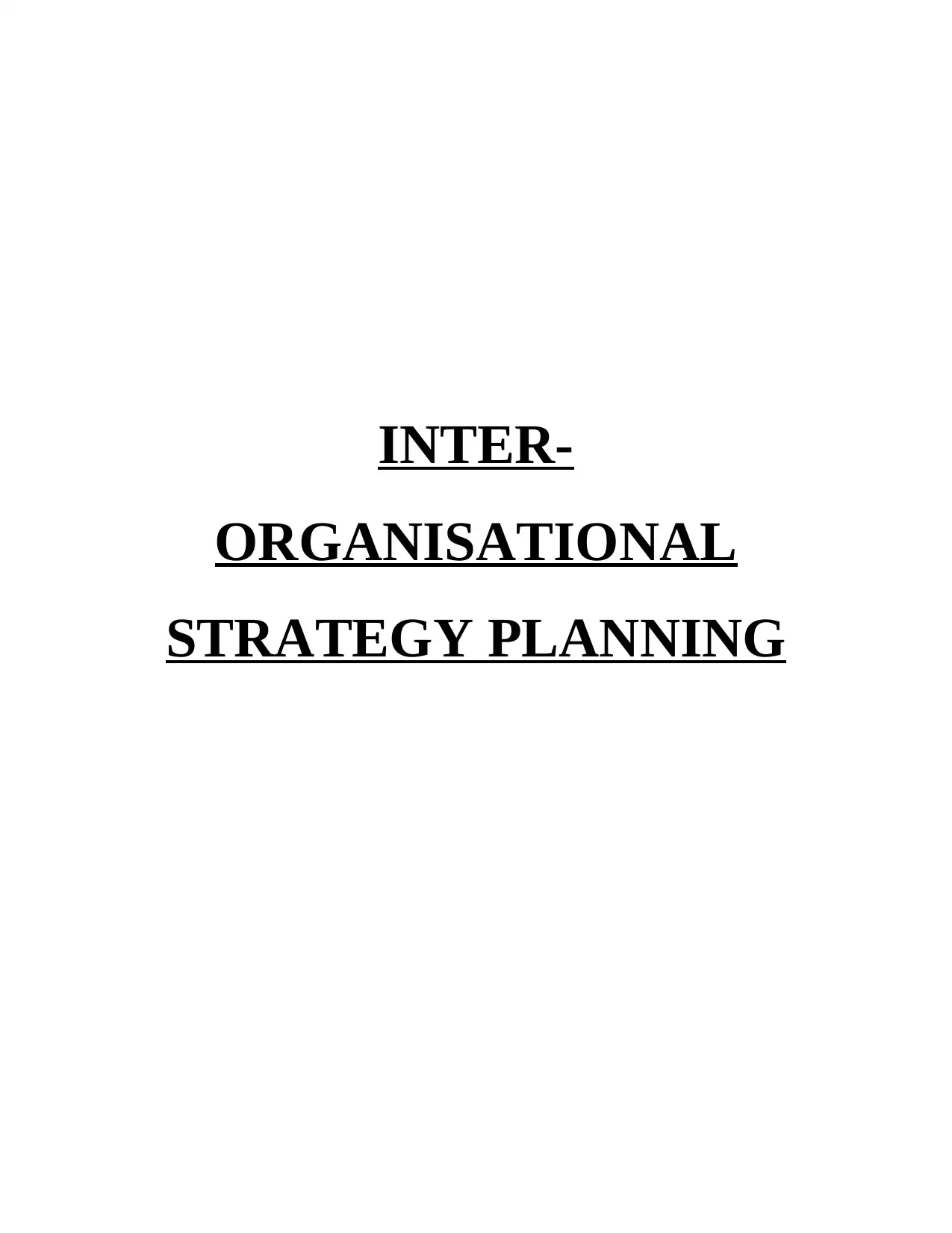
INTER-
ORGANISATIONAL
STRATEGY PLANNING
ORGANISATIONAL
STRATEGY PLANNING
Paraphrase This Document
Need a fresh take? Get an instant paraphrase of this document with our AI Paraphraser
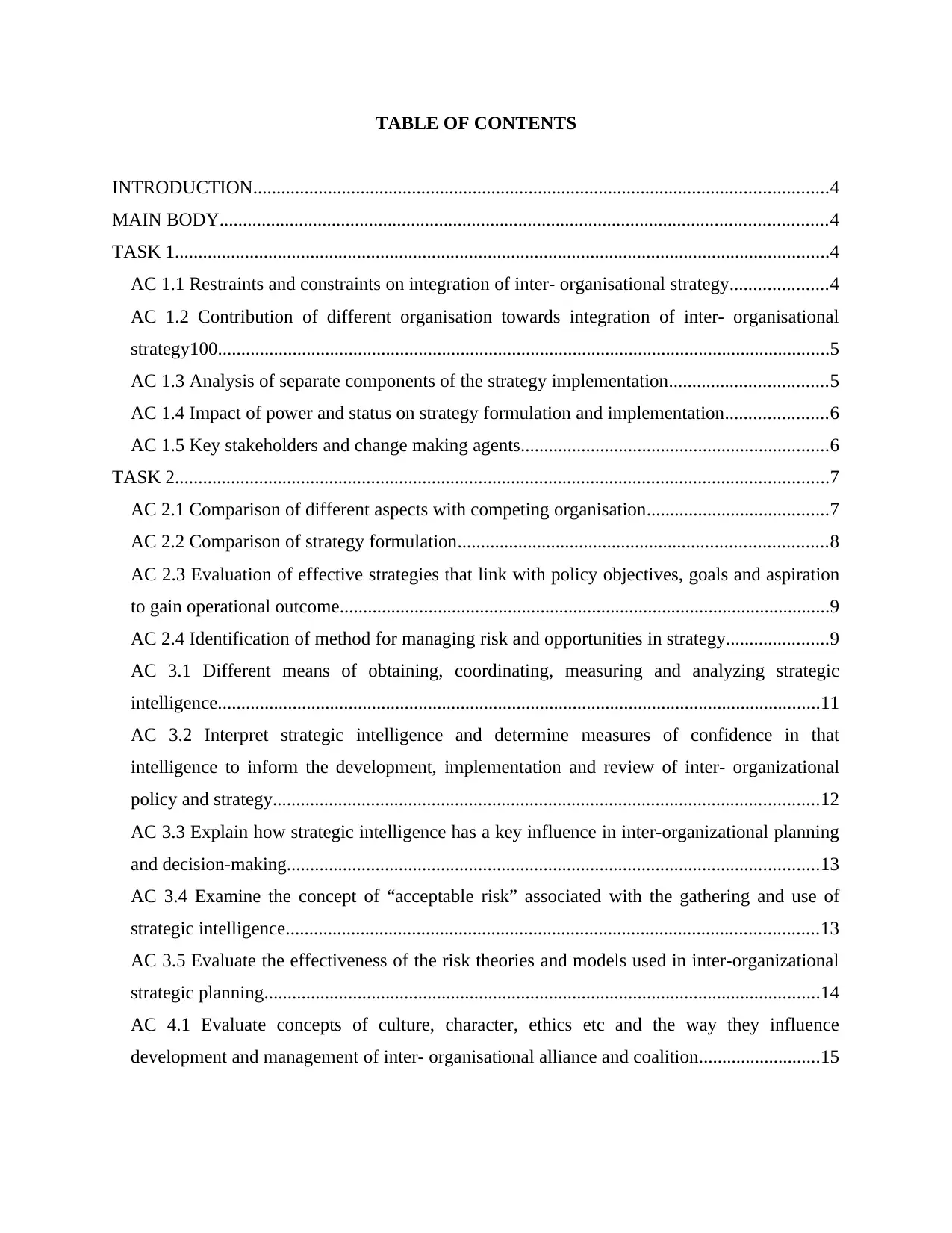
TABLE OF CONTENTS
INTRODUCTION...........................................................................................................................4
MAIN BODY..................................................................................................................................4
TASK 1............................................................................................................................................4
AC 1.1 Restraints and constraints on integration of inter- organisational strategy.....................4
AC 1.2 Contribution of different organisation towards integration of inter- organisational
strategy100...................................................................................................................................5
AC 1.3 Analysis of separate components of the strategy implementation..................................5
AC 1.4 Impact of power and status on strategy formulation and implementation......................6
AC 1.5 Key stakeholders and change making agents..................................................................6
TASK 2............................................................................................................................................7
AC 2.1 Comparison of different aspects with competing organisation.......................................7
AC 2.2 Comparison of strategy formulation...............................................................................8
AC 2.3 Evaluation of effective strategies that link with policy objectives, goals and aspiration
to gain operational outcome.........................................................................................................9
AC 2.4 Identification of method for managing risk and opportunities in strategy......................9
AC 3.1 Different means of obtaining, coordinating, measuring and analyzing strategic
intelligence.................................................................................................................................11
AC 3.2 Interpret strategic intelligence and determine measures of confidence in that
intelligence to inform the development, implementation and review of inter- organizational
policy and strategy.....................................................................................................................12
AC 3.3 Explain how strategic intelligence has a key influence in inter-organizational planning
and decision-making..................................................................................................................13
AC 3.4 Examine the concept of “acceptable risk” associated with the gathering and use of
strategic intelligence..................................................................................................................13
AC 3.5 Evaluate the effectiveness of the risk theories and models used in inter-organizational
strategic planning.......................................................................................................................14
AC 4.1 Evaluate concepts of culture, character, ethics etc and the way they influence
development and management of inter- organisational alliance and coalition..........................15
INTRODUCTION...........................................................................................................................4
MAIN BODY..................................................................................................................................4
TASK 1............................................................................................................................................4
AC 1.1 Restraints and constraints on integration of inter- organisational strategy.....................4
AC 1.2 Contribution of different organisation towards integration of inter- organisational
strategy100...................................................................................................................................5
AC 1.3 Analysis of separate components of the strategy implementation..................................5
AC 1.4 Impact of power and status on strategy formulation and implementation......................6
AC 1.5 Key stakeholders and change making agents..................................................................6
TASK 2............................................................................................................................................7
AC 2.1 Comparison of different aspects with competing organisation.......................................7
AC 2.2 Comparison of strategy formulation...............................................................................8
AC 2.3 Evaluation of effective strategies that link with policy objectives, goals and aspiration
to gain operational outcome.........................................................................................................9
AC 2.4 Identification of method for managing risk and opportunities in strategy......................9
AC 3.1 Different means of obtaining, coordinating, measuring and analyzing strategic
intelligence.................................................................................................................................11
AC 3.2 Interpret strategic intelligence and determine measures of confidence in that
intelligence to inform the development, implementation and review of inter- organizational
policy and strategy.....................................................................................................................12
AC 3.3 Explain how strategic intelligence has a key influence in inter-organizational planning
and decision-making..................................................................................................................13
AC 3.4 Examine the concept of “acceptable risk” associated with the gathering and use of
strategic intelligence..................................................................................................................13
AC 3.5 Evaluate the effectiveness of the risk theories and models used in inter-organizational
strategic planning.......................................................................................................................14
AC 4.1 Evaluate concepts of culture, character, ethics etc and the way they influence
development and management of inter- organisational alliance and coalition..........................15
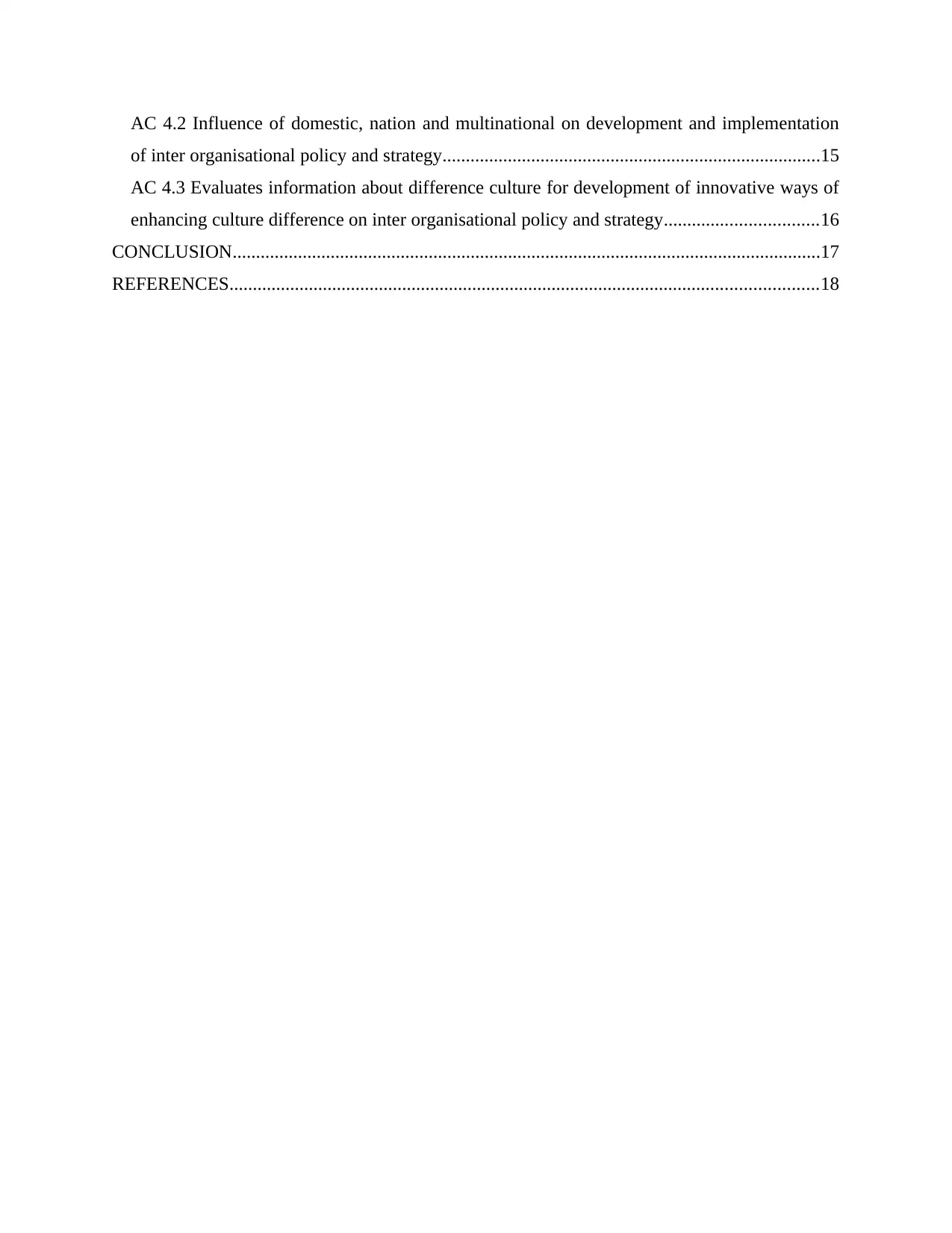
AC 4.2 Influence of domestic, nation and multinational on development and implementation
of inter organisational policy and strategy.................................................................................15
AC 4.3 Evaluates information about difference culture for development of innovative ways of
enhancing culture difference on inter organisational policy and strategy.................................16
CONCLUSION..............................................................................................................................17
REFERENCES..............................................................................................................................18
of inter organisational policy and strategy.................................................................................15
AC 4.3 Evaluates information about difference culture for development of innovative ways of
enhancing culture difference on inter organisational policy and strategy.................................16
CONCLUSION..............................................................................................................................17
REFERENCES..............................................................................................................................18
⊘ This is a preview!⊘
Do you want full access?
Subscribe today to unlock all pages.

Trusted by 1+ million students worldwide
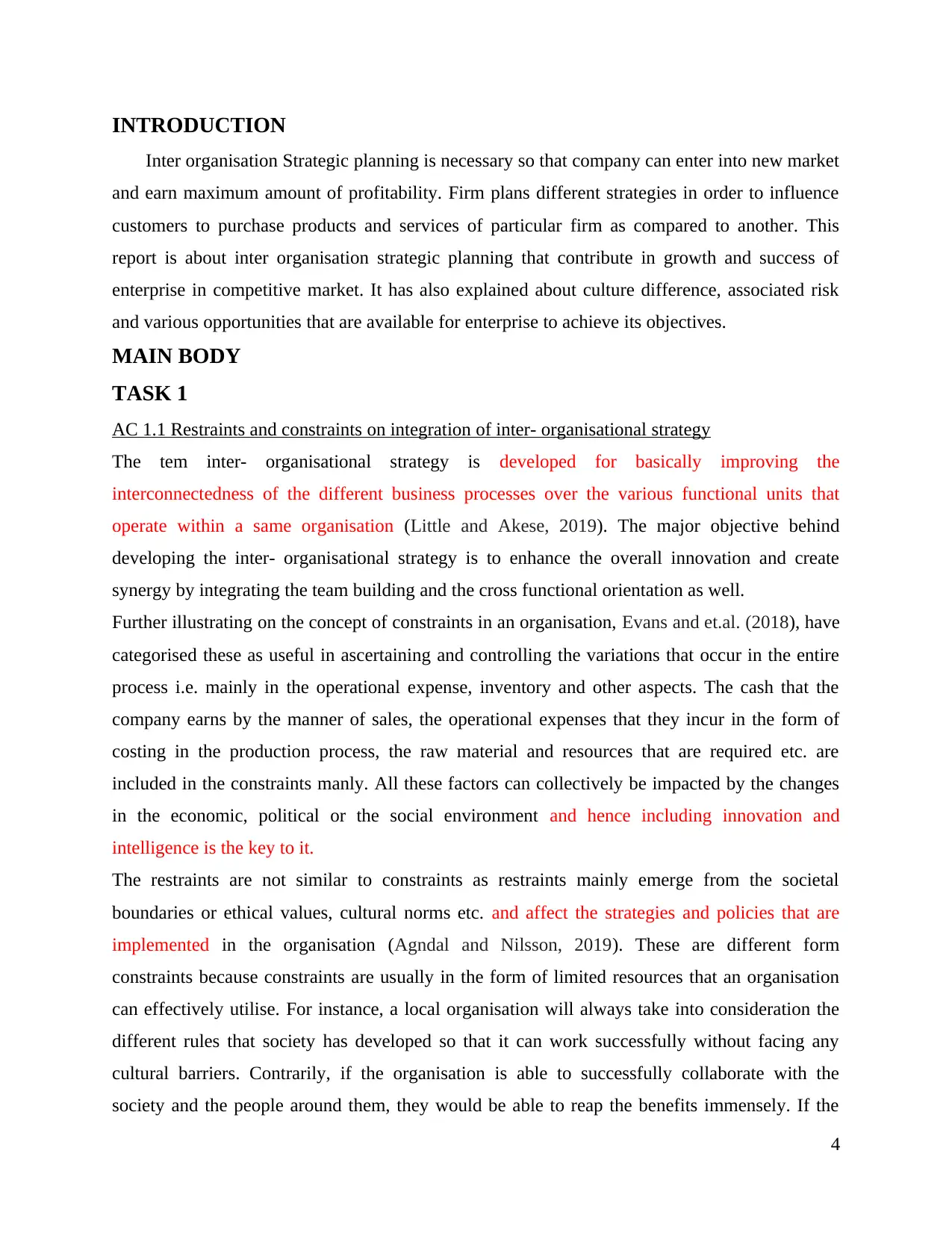
INTRODUCTION
Inter organisation Strategic planning is necessary so that company can enter into new market
and earn maximum amount of profitability. Firm plans different strategies in order to influence
customers to purchase products and services of particular firm as compared to another. This
report is about inter organisation strategic planning that contribute in growth and success of
enterprise in competitive market. It has also explained about culture difference, associated risk
and various opportunities that are available for enterprise to achieve its objectives.
MAIN BODY
TASK 1
AC 1.1 Restraints and constraints on integration of inter- organisational strategy
The tem inter- organisational strategy is developed for basically improving the
interconnectedness of the different business processes over the various functional units that
operate within a same organisation (Little and Akese, 2019). The major objective behind
developing the inter- organisational strategy is to enhance the overall innovation and create
synergy by integrating the team building and the cross functional orientation as well.
Further illustrating on the concept of constraints in an organisation, Evans and et.al. (2018), have
categorised these as useful in ascertaining and controlling the variations that occur in the entire
process i.e. mainly in the operational expense, inventory and other aspects. The cash that the
company earns by the manner of sales, the operational expenses that they incur in the form of
costing in the production process, the raw material and resources that are required etc. are
included in the constraints manly. All these factors can collectively be impacted by the changes
in the economic, political or the social environment and hence including innovation and
intelligence is the key to it.
The restraints are not similar to constraints as restraints mainly emerge from the societal
boundaries or ethical values, cultural norms etc. and affect the strategies and policies that are
implemented in the organisation (Agndal and Nilsson, 2019). These are different form
constraints because constraints are usually in the form of limited resources that an organisation
can effectively utilise. For instance, a local organisation will always take into consideration the
different rules that society has developed so that it can work successfully without facing any
cultural barriers. Contrarily, if the organisation is able to successfully collaborate with the
society and the people around them, they would be able to reap the benefits immensely. If the
4
Inter organisation Strategic planning is necessary so that company can enter into new market
and earn maximum amount of profitability. Firm plans different strategies in order to influence
customers to purchase products and services of particular firm as compared to another. This
report is about inter organisation strategic planning that contribute in growth and success of
enterprise in competitive market. It has also explained about culture difference, associated risk
and various opportunities that are available for enterprise to achieve its objectives.
MAIN BODY
TASK 1
AC 1.1 Restraints and constraints on integration of inter- organisational strategy
The tem inter- organisational strategy is developed for basically improving the
interconnectedness of the different business processes over the various functional units that
operate within a same organisation (Little and Akese, 2019). The major objective behind
developing the inter- organisational strategy is to enhance the overall innovation and create
synergy by integrating the team building and the cross functional orientation as well.
Further illustrating on the concept of constraints in an organisation, Evans and et.al. (2018), have
categorised these as useful in ascertaining and controlling the variations that occur in the entire
process i.e. mainly in the operational expense, inventory and other aspects. The cash that the
company earns by the manner of sales, the operational expenses that they incur in the form of
costing in the production process, the raw material and resources that are required etc. are
included in the constraints manly. All these factors can collectively be impacted by the changes
in the economic, political or the social environment and hence including innovation and
intelligence is the key to it.
The restraints are not similar to constraints as restraints mainly emerge from the societal
boundaries or ethical values, cultural norms etc. and affect the strategies and policies that are
implemented in the organisation (Agndal and Nilsson, 2019). These are different form
constraints because constraints are usually in the form of limited resources that an organisation
can effectively utilise. For instance, a local organisation will always take into consideration the
different rules that society has developed so that it can work successfully without facing any
cultural barriers. Contrarily, if the organisation is able to successfully collaborate with the
society and the people around them, they would be able to reap the benefits immensely. If the
4
Paraphrase This Document
Need a fresh take? Get an instant paraphrase of this document with our AI Paraphraser
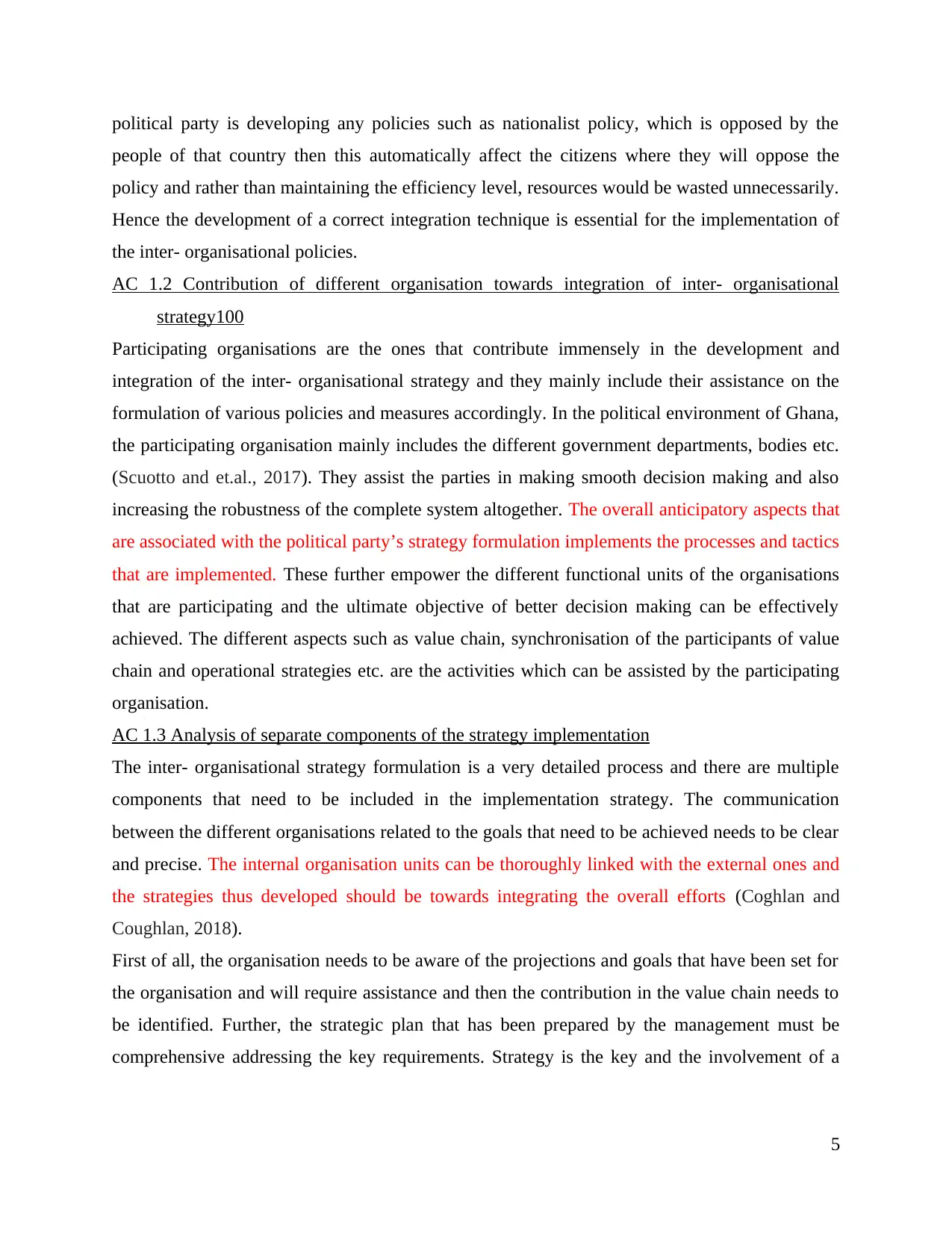
political party is developing any policies such as nationalist policy, which is opposed by the
people of that country then this automatically affect the citizens where they will oppose the
policy and rather than maintaining the efficiency level, resources would be wasted unnecessarily.
Hence the development of a correct integration technique is essential for the implementation of
the inter- organisational policies.
AC 1.2 Contribution of different organisation towards integration of inter- organisational
strategy100
Participating organisations are the ones that contribute immensely in the development and
integration of the inter- organisational strategy and they mainly include their assistance on the
formulation of various policies and measures accordingly. In the political environment of Ghana,
the participating organisation mainly includes the different government departments, bodies etc.
(Scuotto and et.al., 2017). They assist the parties in making smooth decision making and also
increasing the robustness of the complete system altogether. The overall anticipatory aspects that
are associated with the political party’s strategy formulation implements the processes and tactics
that are implemented. These further empower the different functional units of the organisations
that are participating and the ultimate objective of better decision making can be effectively
achieved. The different aspects such as value chain, synchronisation of the participants of value
chain and operational strategies etc. are the activities which can be assisted by the participating
organisation.
AC 1.3 Analysis of separate components of the strategy implementation
The inter- organisational strategy formulation is a very detailed process and there are multiple
components that need to be included in the implementation strategy. The communication
between the different organisations related to the goals that need to be achieved needs to be clear
and precise. The internal organisation units can be thoroughly linked with the external ones and
the strategies thus developed should be towards integrating the overall efforts (Coghlan and
Coughlan, 2018).
First of all, the organisation needs to be aware of the projections and goals that have been set for
the organisation and will require assistance and then the contribution in the value chain needs to
be identified. Further, the strategic plan that has been prepared by the management must be
comprehensive addressing the key requirements. Strategy is the key and the involvement of a
5
people of that country then this automatically affect the citizens where they will oppose the
policy and rather than maintaining the efficiency level, resources would be wasted unnecessarily.
Hence the development of a correct integration technique is essential for the implementation of
the inter- organisational policies.
AC 1.2 Contribution of different organisation towards integration of inter- organisational
strategy100
Participating organisations are the ones that contribute immensely in the development and
integration of the inter- organisational strategy and they mainly include their assistance on the
formulation of various policies and measures accordingly. In the political environment of Ghana,
the participating organisation mainly includes the different government departments, bodies etc.
(Scuotto and et.al., 2017). They assist the parties in making smooth decision making and also
increasing the robustness of the complete system altogether. The overall anticipatory aspects that
are associated with the political party’s strategy formulation implements the processes and tactics
that are implemented. These further empower the different functional units of the organisations
that are participating and the ultimate objective of better decision making can be effectively
achieved. The different aspects such as value chain, synchronisation of the participants of value
chain and operational strategies etc. are the activities which can be assisted by the participating
organisation.
AC 1.3 Analysis of separate components of the strategy implementation
The inter- organisational strategy formulation is a very detailed process and there are multiple
components that need to be included in the implementation strategy. The communication
between the different organisations related to the goals that need to be achieved needs to be clear
and precise. The internal organisation units can be thoroughly linked with the external ones and
the strategies thus developed should be towards integrating the overall efforts (Coghlan and
Coughlan, 2018).
First of all, the organisation needs to be aware of the projections and goals that have been set for
the organisation and will require assistance and then the contribution in the value chain needs to
be identified. Further, the strategic plan that has been prepared by the management must be
comprehensive addressing the key requirements. Strategy is the key and the involvement of a
5
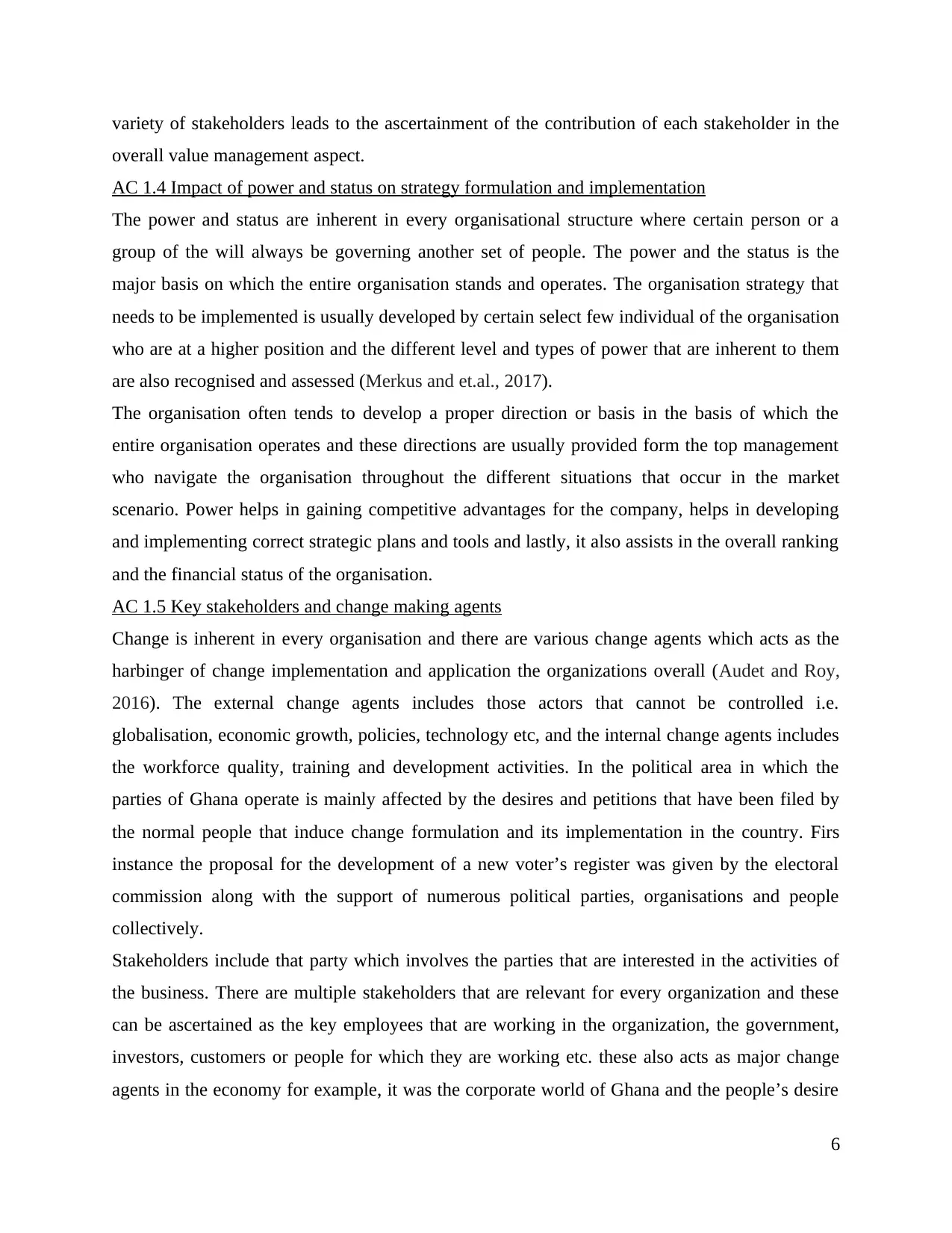
variety of stakeholders leads to the ascertainment of the contribution of each stakeholder in the
overall value management aspect.
AC 1.4 Impact of power and status on strategy formulation and implementation
The power and status are inherent in every organisational structure where certain person or a
group of the will always be governing another set of people. The power and the status is the
major basis on which the entire organisation stands and operates. The organisation strategy that
needs to be implemented is usually developed by certain select few individual of the organisation
who are at a higher position and the different level and types of power that are inherent to them
are also recognised and assessed (Merkus and et.al., 2017).
The organisation often tends to develop a proper direction or basis in the basis of which the
entire organisation operates and these directions are usually provided form the top management
who navigate the organisation throughout the different situations that occur in the market
scenario. Power helps in gaining competitive advantages for the company, helps in developing
and implementing correct strategic plans and tools and lastly, it also assists in the overall ranking
and the financial status of the organisation.
AC 1.5 Key stakeholders and change making agents
Change is inherent in every organisation and there are various change agents which acts as the
harbinger of change implementation and application the organizations overall (Audet and Roy,
2016). The external change agents includes those actors that cannot be controlled i.e.
globalisation, economic growth, policies, technology etc, and the internal change agents includes
the workforce quality, training and development activities. In the political area in which the
parties of Ghana operate is mainly affected by the desires and petitions that have been filed by
the normal people that induce change formulation and its implementation in the country. Firs
instance the proposal for the development of a new voter’s register was given by the electoral
commission along with the support of numerous political parties, organisations and people
collectively.
Stakeholders include that party which involves the parties that are interested in the activities of
the business. There are multiple stakeholders that are relevant for every organization and these
can be ascertained as the key employees that are working in the organization, the government,
investors, customers or people for which they are working etc. these also acts as major change
agents in the economy for example, it was the corporate world of Ghana and the people’s desire
6
overall value management aspect.
AC 1.4 Impact of power and status on strategy formulation and implementation
The power and status are inherent in every organisational structure where certain person or a
group of the will always be governing another set of people. The power and the status is the
major basis on which the entire organisation stands and operates. The organisation strategy that
needs to be implemented is usually developed by certain select few individual of the organisation
who are at a higher position and the different level and types of power that are inherent to them
are also recognised and assessed (Merkus and et.al., 2017).
The organisation often tends to develop a proper direction or basis in the basis of which the
entire organisation operates and these directions are usually provided form the top management
who navigate the organisation throughout the different situations that occur in the market
scenario. Power helps in gaining competitive advantages for the company, helps in developing
and implementing correct strategic plans and tools and lastly, it also assists in the overall ranking
and the financial status of the organisation.
AC 1.5 Key stakeholders and change making agents
Change is inherent in every organisation and there are various change agents which acts as the
harbinger of change implementation and application the organizations overall (Audet and Roy,
2016). The external change agents includes those actors that cannot be controlled i.e.
globalisation, economic growth, policies, technology etc, and the internal change agents includes
the workforce quality, training and development activities. In the political area in which the
parties of Ghana operate is mainly affected by the desires and petitions that have been filed by
the normal people that induce change formulation and its implementation in the country. Firs
instance the proposal for the development of a new voter’s register was given by the electoral
commission along with the support of numerous political parties, organisations and people
collectively.
Stakeholders include that party which involves the parties that are interested in the activities of
the business. There are multiple stakeholders that are relevant for every organization and these
can be ascertained as the key employees that are working in the organization, the government,
investors, customers or people for which they are working etc. these also acts as major change
agents in the economy for example, it was the corporate world of Ghana and the people’s desire
6
⊘ This is a preview!⊘
Do you want full access?
Subscribe today to unlock all pages.

Trusted by 1+ million students worldwide
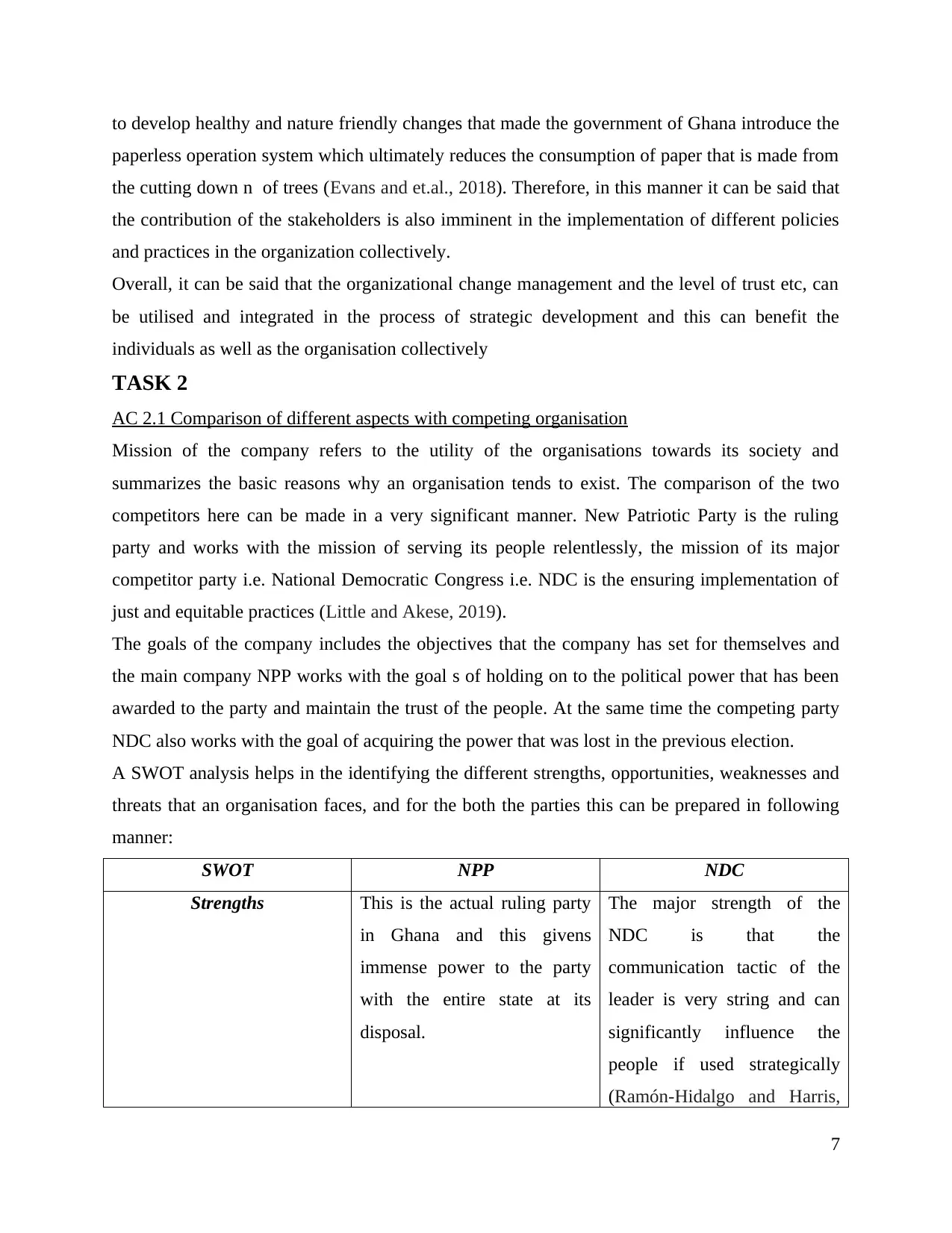
to develop healthy and nature friendly changes that made the government of Ghana introduce the
paperless operation system which ultimately reduces the consumption of paper that is made from
the cutting down n of trees (Evans and et.al., 2018). Therefore, in this manner it can be said that
the contribution of the stakeholders is also imminent in the implementation of different policies
and practices in the organization collectively.
Overall, it can be said that the organizational change management and the level of trust etc, can
be utilised and integrated in the process of strategic development and this can benefit the
individuals as well as the organisation collectively
TASK 2
AC 2.1 Comparison of different aspects with competing organisation
Mission of the company refers to the utility of the organisations towards its society and
summarizes the basic reasons why an organisation tends to exist. The comparison of the two
competitors here can be made in a very significant manner. New Patriotic Party is the ruling
party and works with the mission of serving its people relentlessly, the mission of its major
competitor party i.e. National Democratic Congress i.e. NDC is the ensuring implementation of
just and equitable practices (Little and Akese, 2019).
The goals of the company includes the objectives that the company has set for themselves and
the main company NPP works with the goal s of holding on to the political power that has been
awarded to the party and maintain the trust of the people. At the same time the competing party
NDC also works with the goal of acquiring the power that was lost in the previous election.
A SWOT analysis helps in the identifying the different strengths, opportunities, weaknesses and
threats that an organisation faces, and for the both the parties this can be prepared in following
manner:
SWOT NPP NDC
Strengths This is the actual ruling party
in Ghana and this givens
immense power to the party
with the entire state at its
disposal.
The major strength of the
NDC is that the
communication tactic of the
leader is very string and can
significantly influence the
people if used strategically
(Ramón-Hidalgo and Harris,
7
paperless operation system which ultimately reduces the consumption of paper that is made from
the cutting down n of trees (Evans and et.al., 2018). Therefore, in this manner it can be said that
the contribution of the stakeholders is also imminent in the implementation of different policies
and practices in the organization collectively.
Overall, it can be said that the organizational change management and the level of trust etc, can
be utilised and integrated in the process of strategic development and this can benefit the
individuals as well as the organisation collectively
TASK 2
AC 2.1 Comparison of different aspects with competing organisation
Mission of the company refers to the utility of the organisations towards its society and
summarizes the basic reasons why an organisation tends to exist. The comparison of the two
competitors here can be made in a very significant manner. New Patriotic Party is the ruling
party and works with the mission of serving its people relentlessly, the mission of its major
competitor party i.e. National Democratic Congress i.e. NDC is the ensuring implementation of
just and equitable practices (Little and Akese, 2019).
The goals of the company includes the objectives that the company has set for themselves and
the main company NPP works with the goal s of holding on to the political power that has been
awarded to the party and maintain the trust of the people. At the same time the competing party
NDC also works with the goal of acquiring the power that was lost in the previous election.
A SWOT analysis helps in the identifying the different strengths, opportunities, weaknesses and
threats that an organisation faces, and for the both the parties this can be prepared in following
manner:
SWOT NPP NDC
Strengths This is the actual ruling party
in Ghana and this givens
immense power to the party
with the entire state at its
disposal.
The major strength of the
NDC is that the
communication tactic of the
leader is very string and can
significantly influence the
people if used strategically
(Ramón-Hidalgo and Harris,
7
Paraphrase This Document
Need a fresh take? Get an instant paraphrase of this document with our AI Paraphraser
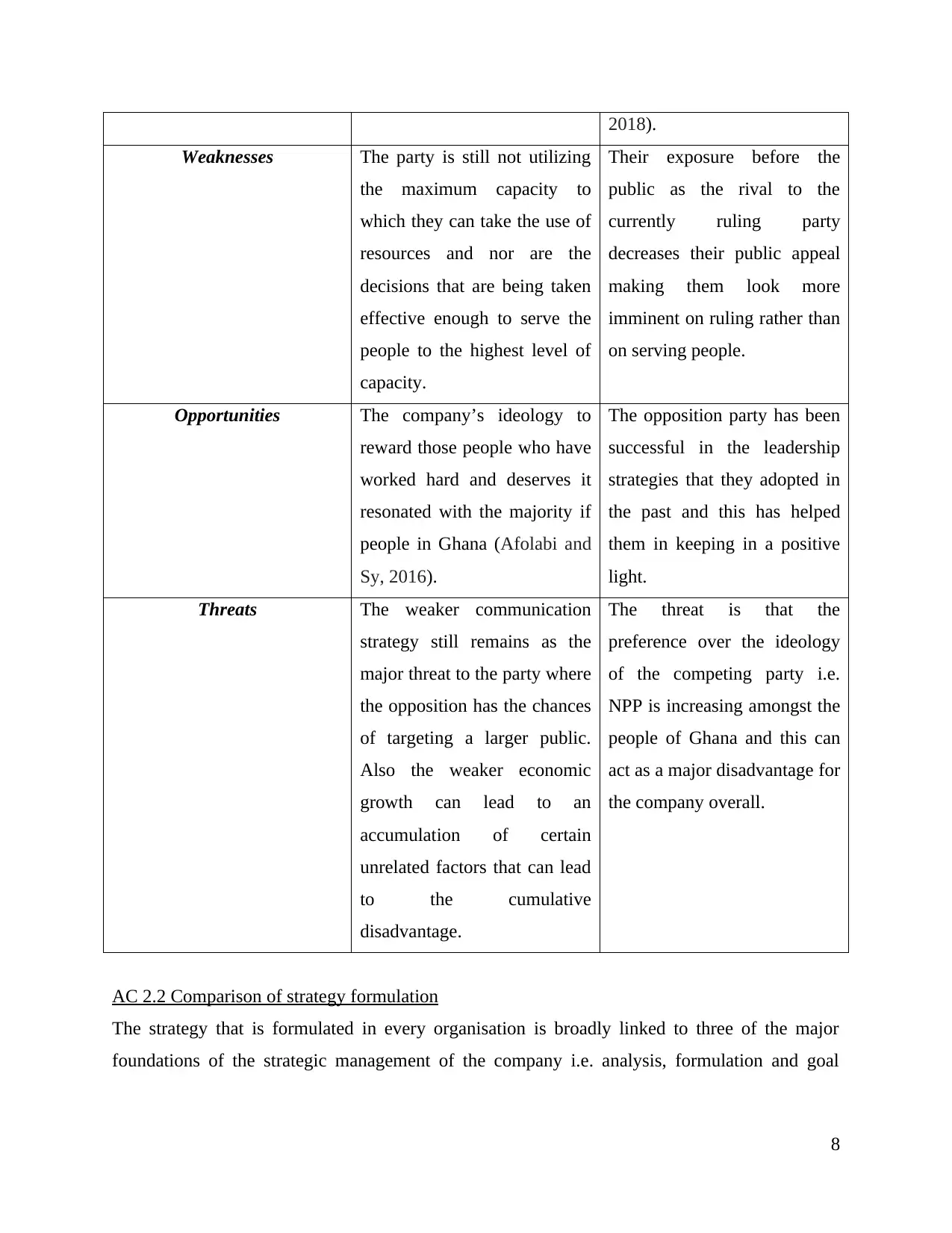
2018).
Weaknesses The party is still not utilizing
the maximum capacity to
which they can take the use of
resources and nor are the
decisions that are being taken
effective enough to serve the
people to the highest level of
capacity.
Their exposure before the
public as the rival to the
currently ruling party
decreases their public appeal
making them look more
imminent on ruling rather than
on serving people.
Opportunities The company’s ideology to
reward those people who have
worked hard and deserves it
resonated with the majority if
people in Ghana (Afolabi and
Sy, 2016).
The opposition party has been
successful in the leadership
strategies that they adopted in
the past and this has helped
them in keeping in a positive
light.
Threats The weaker communication
strategy still remains as the
major threat to the party where
the opposition has the chances
of targeting a larger public.
Also the weaker economic
growth can lead to an
accumulation of certain
unrelated factors that can lead
to the cumulative
disadvantage.
The threat is that the
preference over the ideology
of the competing party i.e.
NPP is increasing amongst the
people of Ghana and this can
act as a major disadvantage for
the company overall.
AC 2.2 Comparison of strategy formulation
The strategy that is formulated in every organisation is broadly linked to three of the major
foundations of the strategic management of the company i.e. analysis, formulation and goal
8
Weaknesses The party is still not utilizing
the maximum capacity to
which they can take the use of
resources and nor are the
decisions that are being taken
effective enough to serve the
people to the highest level of
capacity.
Their exposure before the
public as the rival to the
currently ruling party
decreases their public appeal
making them look more
imminent on ruling rather than
on serving people.
Opportunities The company’s ideology to
reward those people who have
worked hard and deserves it
resonated with the majority if
people in Ghana (Afolabi and
Sy, 2016).
The opposition party has been
successful in the leadership
strategies that they adopted in
the past and this has helped
them in keeping in a positive
light.
Threats The weaker communication
strategy still remains as the
major threat to the party where
the opposition has the chances
of targeting a larger public.
Also the weaker economic
growth can lead to an
accumulation of certain
unrelated factors that can lead
to the cumulative
disadvantage.
The threat is that the
preference over the ideology
of the competing party i.e.
NPP is increasing amongst the
people of Ghana and this can
act as a major disadvantage for
the company overall.
AC 2.2 Comparison of strategy formulation
The strategy that is formulated in every organisation is broadly linked to three of the major
foundations of the strategic management of the company i.e. analysis, formulation and goal
8
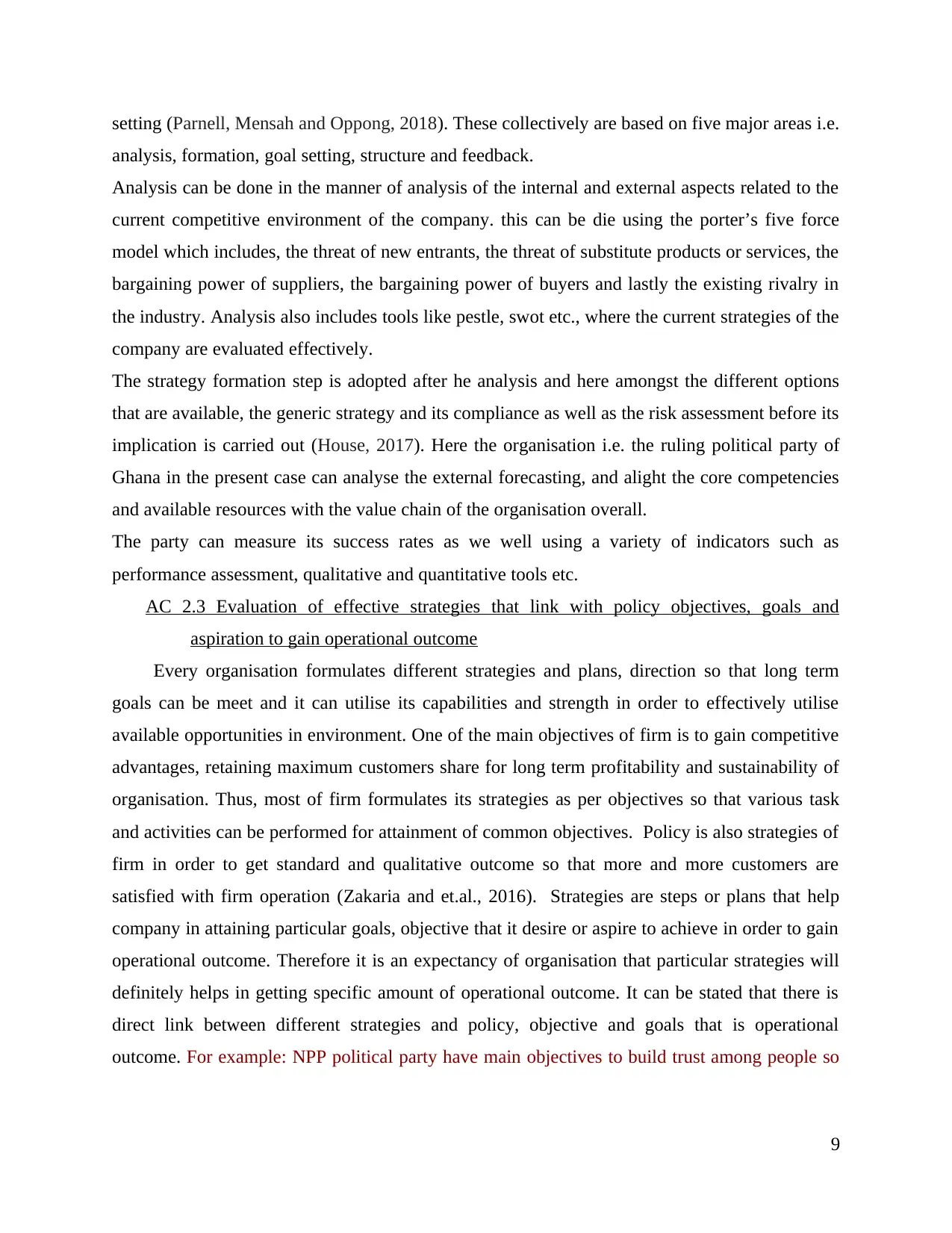
setting (Parnell, Mensah and Oppong, 2018). These collectively are based on five major areas i.e.
analysis, formation, goal setting, structure and feedback.
Analysis can be done in the manner of analysis of the internal and external aspects related to the
current competitive environment of the company. this can be die using the porter’s five force
model which includes, the threat of new entrants, the threat of substitute products or services, the
bargaining power of suppliers, the bargaining power of buyers and lastly the existing rivalry in
the industry. Analysis also includes tools like pestle, swot etc., where the current strategies of the
company are evaluated effectively.
The strategy formation step is adopted after he analysis and here amongst the different options
that are available, the generic strategy and its compliance as well as the risk assessment before its
implication is carried out (House, 2017). Here the organisation i.e. the ruling political party of
Ghana in the present case can analyse the external forecasting, and alight the core competencies
and available resources with the value chain of the organisation overall.
The party can measure its success rates as we well using a variety of indicators such as
performance assessment, qualitative and quantitative tools etc.
AC 2.3 Evaluation of effective strategies that link with policy objectives, goals and
aspiration to gain operational outcome
Every organisation formulates different strategies and plans, direction so that long term
goals can be meet and it can utilise its capabilities and strength in order to effectively utilise
available opportunities in environment. One of the main objectives of firm is to gain competitive
advantages, retaining maximum customers share for long term profitability and sustainability of
organisation. Thus, most of firm formulates its strategies as per objectives so that various task
and activities can be performed for attainment of common objectives. Policy is also strategies of
firm in order to get standard and qualitative outcome so that more and more customers are
satisfied with firm operation (Zakaria and et.al., 2016). Strategies are steps or plans that help
company in attaining particular goals, objective that it desire or aspire to achieve in order to gain
operational outcome. Therefore it is an expectancy of organisation that particular strategies will
definitely helps in getting specific amount of operational outcome. It can be stated that there is
direct link between different strategies and policy, objective and goals that is operational
outcome. For example: NPP political party have main objectives to build trust among people so
9
analysis, formation, goal setting, structure and feedback.
Analysis can be done in the manner of analysis of the internal and external aspects related to the
current competitive environment of the company. this can be die using the porter’s five force
model which includes, the threat of new entrants, the threat of substitute products or services, the
bargaining power of suppliers, the bargaining power of buyers and lastly the existing rivalry in
the industry. Analysis also includes tools like pestle, swot etc., where the current strategies of the
company are evaluated effectively.
The strategy formation step is adopted after he analysis and here amongst the different options
that are available, the generic strategy and its compliance as well as the risk assessment before its
implication is carried out (House, 2017). Here the organisation i.e. the ruling political party of
Ghana in the present case can analyse the external forecasting, and alight the core competencies
and available resources with the value chain of the organisation overall.
The party can measure its success rates as we well using a variety of indicators such as
performance assessment, qualitative and quantitative tools etc.
AC 2.3 Evaluation of effective strategies that link with policy objectives, goals and
aspiration to gain operational outcome
Every organisation formulates different strategies and plans, direction so that long term
goals can be meet and it can utilise its capabilities and strength in order to effectively utilise
available opportunities in environment. One of the main objectives of firm is to gain competitive
advantages, retaining maximum customers share for long term profitability and sustainability of
organisation. Thus, most of firm formulates its strategies as per objectives so that various task
and activities can be performed for attainment of common objectives. Policy is also strategies of
firm in order to get standard and qualitative outcome so that more and more customers are
satisfied with firm operation (Zakaria and et.al., 2016). Strategies are steps or plans that help
company in attaining particular goals, objective that it desire or aspire to achieve in order to gain
operational outcome. Therefore it is an expectancy of organisation that particular strategies will
definitely helps in getting specific amount of operational outcome. It can be stated that there is
direct link between different strategies and policy, objective and goals that is operational
outcome. For example: NPP political party have main objectives to build trust among people so
9
⊘ This is a preview!⊘
Do you want full access?
Subscribe today to unlock all pages.

Trusted by 1+ million students worldwide
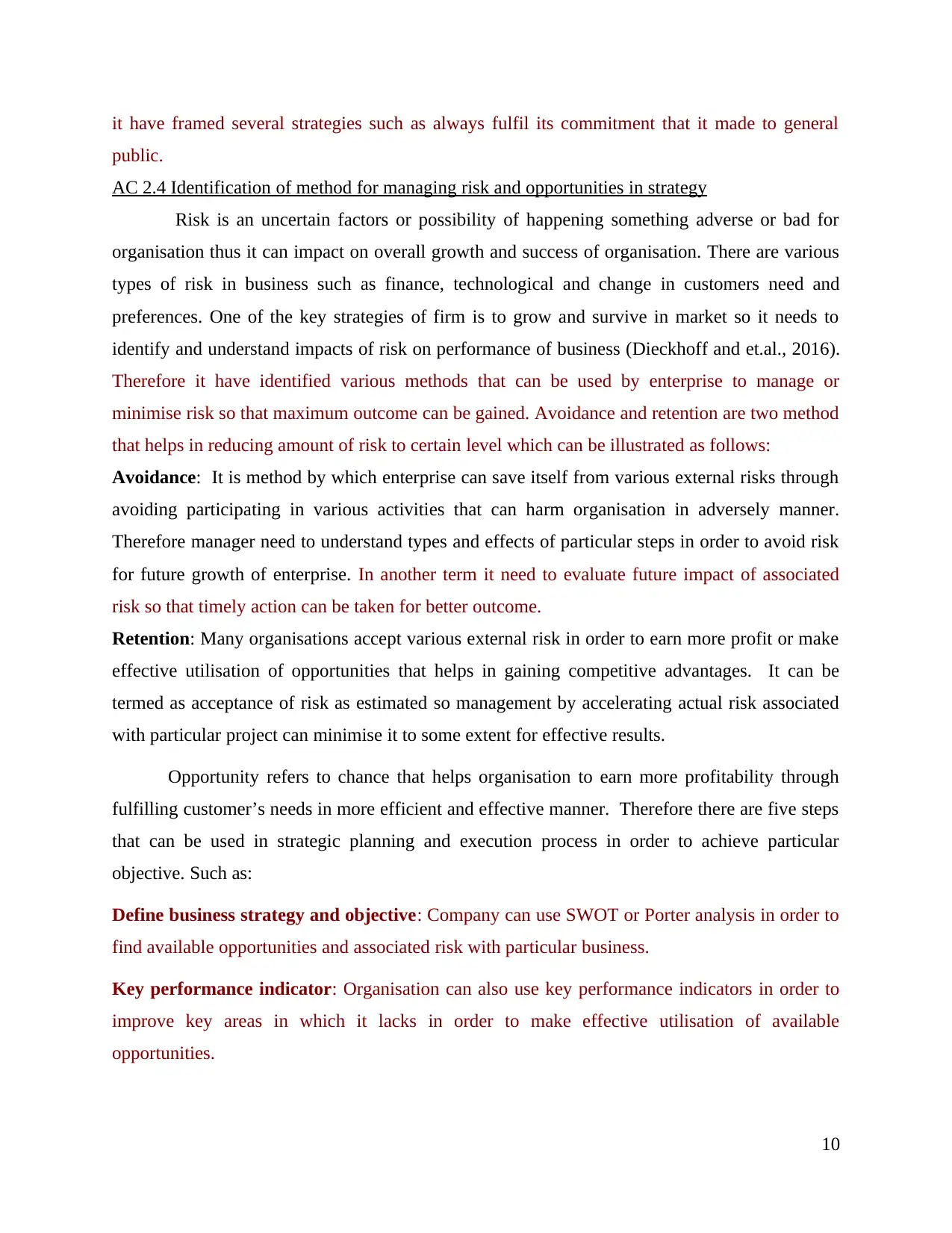
it have framed several strategies such as always fulfil its commitment that it made to general
public.
AC 2.4 Identification of method for managing risk and opportunities in strategy
Risk is an uncertain factors or possibility of happening something adverse or bad for
organisation thus it can impact on overall growth and success of organisation. There are various
types of risk in business such as finance, technological and change in customers need and
preferences. One of the key strategies of firm is to grow and survive in market so it needs to
identify and understand impacts of risk on performance of business (Dieckhoff and et.al., 2016).
Therefore it have identified various methods that can be used by enterprise to manage or
minimise risk so that maximum outcome can be gained. Avoidance and retention are two method
that helps in reducing amount of risk to certain level which can be illustrated as follows:
Avoidance: It is method by which enterprise can save itself from various external risks through
avoiding participating in various activities that can harm organisation in adversely manner.
Therefore manager need to understand types and effects of particular steps in order to avoid risk
for future growth of enterprise. In another term it need to evaluate future impact of associated
risk so that timely action can be taken for better outcome.
Retention: Many organisations accept various external risk in order to earn more profit or make
effective utilisation of opportunities that helps in gaining competitive advantages. It can be
termed as acceptance of risk as estimated so management by accelerating actual risk associated
with particular project can minimise it to some extent for effective results.
Opportunity refers to chance that helps organisation to earn more profitability through
fulfilling customer’s needs in more efficient and effective manner. Therefore there are five steps
that can be used in strategic planning and execution process in order to achieve particular
objective. Such as:
Define business strategy and objective: Company can use SWOT or Porter analysis in order to
find available opportunities and associated risk with particular business.
Key performance indicator: Organisation can also use key performance indicators in order to
improve key areas in which it lacks in order to make effective utilisation of available
opportunities.
10
public.
AC 2.4 Identification of method for managing risk and opportunities in strategy
Risk is an uncertain factors or possibility of happening something adverse or bad for
organisation thus it can impact on overall growth and success of organisation. There are various
types of risk in business such as finance, technological and change in customers need and
preferences. One of the key strategies of firm is to grow and survive in market so it needs to
identify and understand impacts of risk on performance of business (Dieckhoff and et.al., 2016).
Therefore it have identified various methods that can be used by enterprise to manage or
minimise risk so that maximum outcome can be gained. Avoidance and retention are two method
that helps in reducing amount of risk to certain level which can be illustrated as follows:
Avoidance: It is method by which enterprise can save itself from various external risks through
avoiding participating in various activities that can harm organisation in adversely manner.
Therefore manager need to understand types and effects of particular steps in order to avoid risk
for future growth of enterprise. In another term it need to evaluate future impact of associated
risk so that timely action can be taken for better outcome.
Retention: Many organisations accept various external risk in order to earn more profit or make
effective utilisation of opportunities that helps in gaining competitive advantages. It can be
termed as acceptance of risk as estimated so management by accelerating actual risk associated
with particular project can minimise it to some extent for effective results.
Opportunity refers to chance that helps organisation to earn more profitability through
fulfilling customer’s needs in more efficient and effective manner. Therefore there are five steps
that can be used in strategic planning and execution process in order to achieve particular
objective. Such as:
Define business strategy and objective: Company can use SWOT or Porter analysis in order to
find available opportunities and associated risk with particular business.
Key performance indicator: Organisation can also use key performance indicators in order to
improve key areas in which it lacks in order to make effective utilisation of available
opportunities.
10
Paraphrase This Document
Need a fresh take? Get an instant paraphrase of this document with our AI Paraphraser
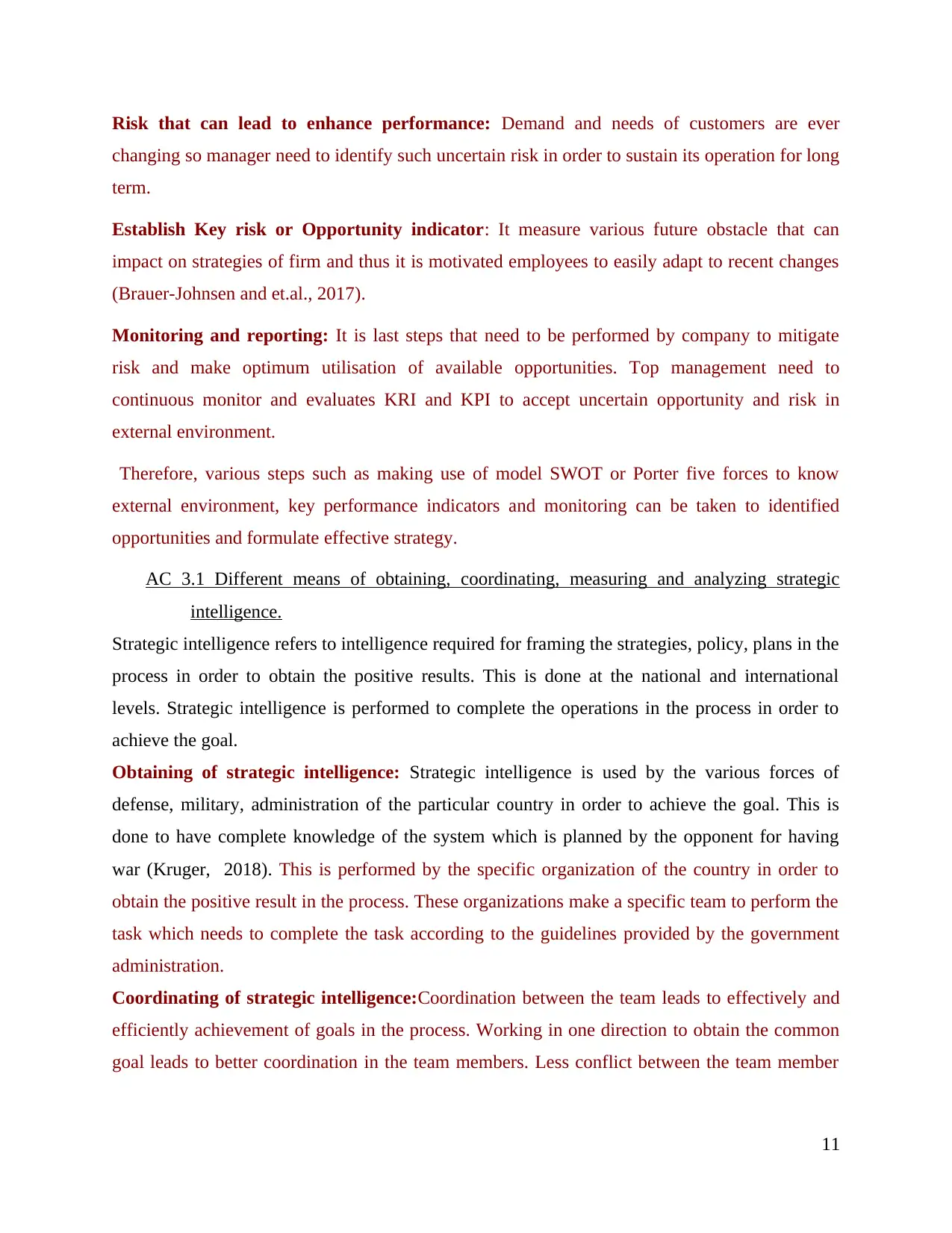
Risk that can lead to enhance performance: Demand and needs of customers are ever
changing so manager need to identify such uncertain risk in order to sustain its operation for long
term.
Establish Key risk or Opportunity indicator: It measure various future obstacle that can
impact on strategies of firm and thus it is motivated employees to easily adapt to recent changes
(Brauer-Johnsen and et.al., 2017).
Monitoring and reporting: It is last steps that need to be performed by company to mitigate
risk and make optimum utilisation of available opportunities. Top management need to
continuous monitor and evaluates KRI and KPI to accept uncertain opportunity and risk in
external environment.
Therefore, various steps such as making use of model SWOT or Porter five forces to know
external environment, key performance indicators and monitoring can be taken to identified
opportunities and formulate effective strategy.
AC 3.1 Different means of obtaining, coordinating, measuring and analyzing strategic
intelligence.
Strategic intelligence refers to intelligence required for framing the strategies, policy, plans in the
process in order to obtain the positive results. This is done at the national and international
levels. Strategic intelligence is performed to complete the operations in the process in order to
achieve the goal.
Obtaining of strategic intelligence: Strategic intelligence is used by the various forces of
defense, military, administration of the particular country in order to achieve the goal. This is
done to have complete knowledge of the system which is planned by the opponent for having
war (Kruger, 2018). This is performed by the specific organization of the country in order to
obtain the positive result in the process. These organizations make a specific team to perform the
task which needs to complete the task according to the guidelines provided by the government
administration.
Coordinating of strategic intelligence:Coordination between the team leads to effectively and
efficiently achievement of goals in the process. Working in one direction to obtain the common
goal leads to better coordination in the team members. Less conflict between the team member
11
changing so manager need to identify such uncertain risk in order to sustain its operation for long
term.
Establish Key risk or Opportunity indicator: It measure various future obstacle that can
impact on strategies of firm and thus it is motivated employees to easily adapt to recent changes
(Brauer-Johnsen and et.al., 2017).
Monitoring and reporting: It is last steps that need to be performed by company to mitigate
risk and make optimum utilisation of available opportunities. Top management need to
continuous monitor and evaluates KRI and KPI to accept uncertain opportunity and risk in
external environment.
Therefore, various steps such as making use of model SWOT or Porter five forces to know
external environment, key performance indicators and monitoring can be taken to identified
opportunities and formulate effective strategy.
AC 3.1 Different means of obtaining, coordinating, measuring and analyzing strategic
intelligence.
Strategic intelligence refers to intelligence required for framing the strategies, policy, plans in the
process in order to obtain the positive results. This is done at the national and international
levels. Strategic intelligence is performed to complete the operations in the process in order to
achieve the goal.
Obtaining of strategic intelligence: Strategic intelligence is used by the various forces of
defense, military, administration of the particular country in order to achieve the goal. This is
done to have complete knowledge of the system which is planned by the opponent for having
war (Kruger, 2018). This is performed by the specific organization of the country in order to
obtain the positive result in the process. These organizations make a specific team to perform the
task which needs to complete the task according to the guidelines provided by the government
administration.
Coordinating of strategic intelligence:Coordination between the team leads to effectively and
efficiently achievement of goals in the process. Working in one direction to obtain the common
goal leads to better coordination in the team members. Less conflict between the team member
11
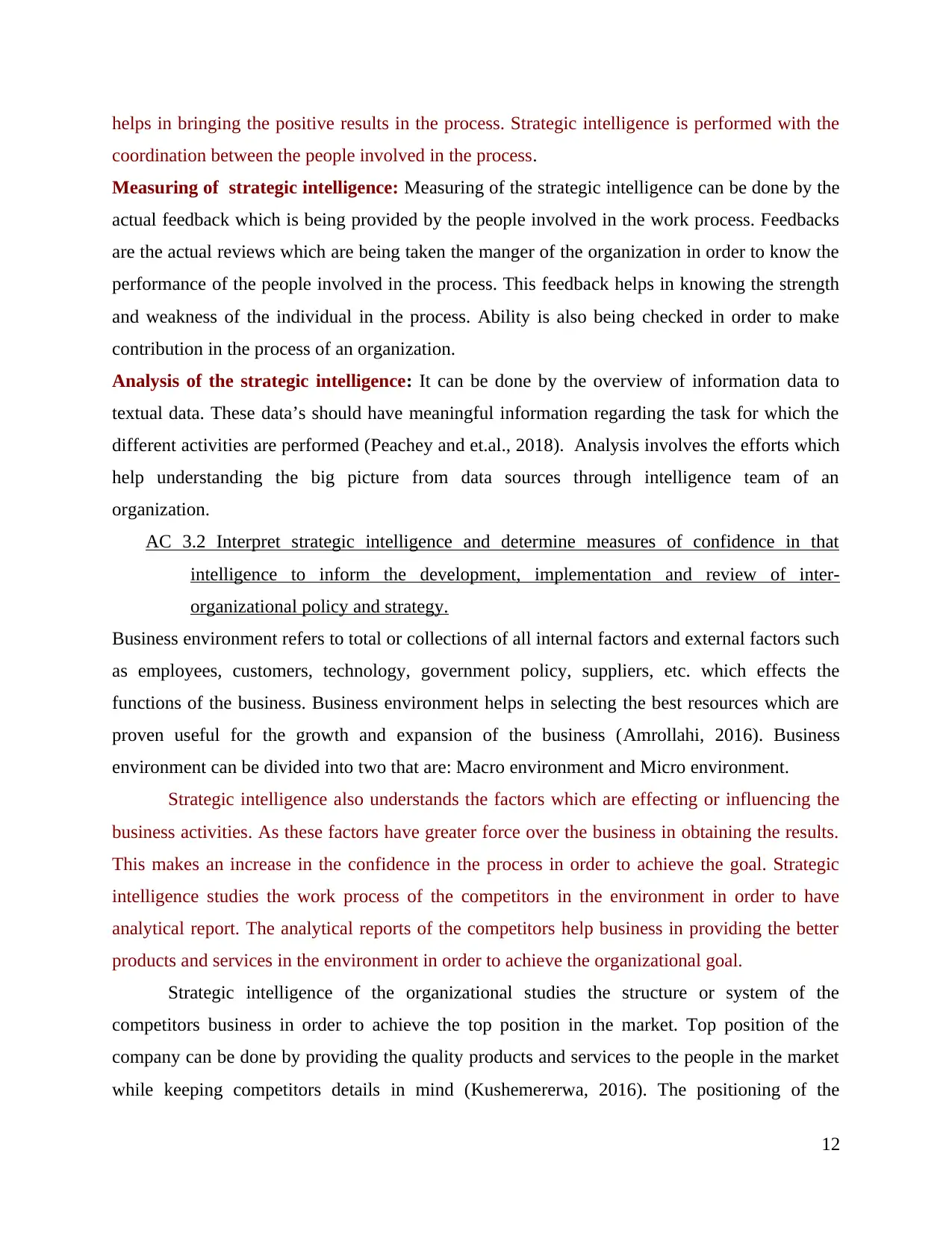
helps in bringing the positive results in the process. Strategic intelligence is performed with the
coordination between the people involved in the process.
Measuring of strategic intelligence: Measuring of the strategic intelligence can be done by the
actual feedback which is being provided by the people involved in the work process. Feedbacks
are the actual reviews which are being taken the manger of the organization in order to know the
performance of the people involved in the process. This feedback helps in knowing the strength
and weakness of the individual in the process. Ability is also being checked in order to make
contribution in the process of an organization.
Analysis of the strategic intelligence: It can be done by the overview of information data to
textual data. These data’s should have meaningful information regarding the task for which the
different activities are performed (Peachey and et.al., 2018). Analysis involves the efforts which
help understanding the big picture from data sources through intelligence team of an
organization.
AC 3.2 Interpret strategic intelligence and determine measures of confidence in that
intelligence to inform the development, implementation and review of inter-
organizational policy and strategy.
Business environment refers to total or collections of all internal factors and external factors such
as employees, customers, technology, government policy, suppliers, etc. which effects the
functions of the business. Business environment helps in selecting the best resources which are
proven useful for the growth and expansion of the business (Amrollahi, 2016). Business
environment can be divided into two that are: Macro environment and Micro environment.
Strategic intelligence also understands the factors which are effecting or influencing the
business activities. As these factors have greater force over the business in obtaining the results.
This makes an increase in the confidence in the process in order to achieve the goal. Strategic
intelligence studies the work process of the competitors in the environment in order to have
analytical report. The analytical reports of the competitors help business in providing the better
products and services in the environment in order to achieve the organizational goal.
Strategic intelligence of the organizational studies the structure or system of the
competitors business in order to achieve the top position in the market. Top position of the
company can be done by providing the quality products and services to the people in the market
while keeping competitors details in mind (Kushemererwa, 2016). The positioning of the
12
coordination between the people involved in the process.
Measuring of strategic intelligence: Measuring of the strategic intelligence can be done by the
actual feedback which is being provided by the people involved in the work process. Feedbacks
are the actual reviews which are being taken the manger of the organization in order to know the
performance of the people involved in the process. This feedback helps in knowing the strength
and weakness of the individual in the process. Ability is also being checked in order to make
contribution in the process of an organization.
Analysis of the strategic intelligence: It can be done by the overview of information data to
textual data. These data’s should have meaningful information regarding the task for which the
different activities are performed (Peachey and et.al., 2018). Analysis involves the efforts which
help understanding the big picture from data sources through intelligence team of an
organization.
AC 3.2 Interpret strategic intelligence and determine measures of confidence in that
intelligence to inform the development, implementation and review of inter-
organizational policy and strategy.
Business environment refers to total or collections of all internal factors and external factors such
as employees, customers, technology, government policy, suppliers, etc. which effects the
functions of the business. Business environment helps in selecting the best resources which are
proven useful for the growth and expansion of the business (Amrollahi, 2016). Business
environment can be divided into two that are: Macro environment and Micro environment.
Strategic intelligence also understands the factors which are effecting or influencing the
business activities. As these factors have greater force over the business in obtaining the results.
This makes an increase in the confidence in the process in order to achieve the goal. Strategic
intelligence studies the work process of the competitors in the environment in order to have
analytical report. The analytical reports of the competitors help business in providing the better
products and services in the environment in order to achieve the organizational goal.
Strategic intelligence of the organizational studies the structure or system of the
competitors business in order to achieve the top position in the market. Top position of the
company can be done by providing the quality products and services to the people in the market
while keeping competitors details in mind (Kushemererwa, 2016). The positioning of the
12
⊘ This is a preview!⊘
Do you want full access?
Subscribe today to unlock all pages.

Trusted by 1+ million students worldwide
1 out of 21
Related Documents
Your All-in-One AI-Powered Toolkit for Academic Success.
+13062052269
info@desklib.com
Available 24*7 on WhatsApp / Email
![[object Object]](/_next/static/media/star-bottom.7253800d.svg)
Unlock your academic potential
Copyright © 2020–2025 A2Z Services. All Rights Reserved. Developed and managed by ZUCOL.





